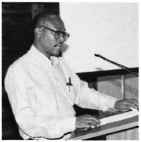- Volume 68 , Number 4
- Page: 475–6
Robert N. Mshana, M.D., Ph.D. 1954-2000

Dr. Robert N. Mshana died tragically in the crash of Kenya Airways Flight KQ 431 off the coast of Abidjan, Ivory Coast, on 30 January 2000. He was returning to Lagos, Nigeria, with his assistant executive secretary from Harare where he had been on an official mission as Executive Secretary of the Organization of African Unity.
He was born in 1954 in Arusha, Tanzania, and studied medicine in Dar-es-Salaam, graduating there as an M.D. in 1979. He was an exceptionally able student, being "picked" by Professor Kaare Lindquist for additional studies abroad already during his medical study. Thus, he came to my laboratory in Oslo to study immunological aspects of mycobacterial infection, partly working in Oslo and partly at our collaborating institution, the Armauer Hansen Research Institute (AHRI) in Addis Ababa, Ethiopia.
He defended his Ph.D. thesis "Immunopathological mechanisms of tissue damage in leprosy" very successfully at The Medical Faculty, University of Oslo, Norway, in 1983. The titles of two of the original papers included in this thesis- "Demonstration of mycobacterial antigens in leprosy tissues" [Int. J. Lepr. 50 (1982) 1-10] and "Nerve damage following intraneural injection of Mycobacterium leprae into rabbits pre-sensitized to mycobacteria" [Clin. Exp. Immunol. 52 (1983) 441-448]-illustrate its main content.
Robert studied and demonstrated mycobacterial antigen in tissue specimens by immunohistochemistry, developing techniques with far greater sensitivity than conventional acid-fast staining. These are essential techniques, also of considerable current interest in studies of various experimental models and for studies of tissue lesions and antigen localization during reactions in leprosy. The findings in his experimental studies of nerve damage supported the concept of tissue damage being induced by delayed-type hypersensitivity (DTH) reactions against antigens released from M. leprae within Schwann cells, the nerve being damaged as an innocent bystander. This view remains valid today, although very recent findings indicate that another mechanism induces nerve damage more directly: A significant fraction of lymphocytes recovered from nerve biopsies taken during reversal reactions are cytotoxic to M. leprae containing Schwann cells functioning as antigen-presenting cells during these conditions.
These matters continued to be among his central interests for a long time after this seminal initial work. They are essential also in today's work on immunological aspects of reactions and at the center of leprosy, being of major importance for induction of acute nerve damage and, thus, a risk factor for chronic disability.
Having finished his Ph.D. studies in Oslo, he sought further training and worked in various institutions, e.g., in the World Health Organization (WHO) Immunology and Research Training Center in Lausanne, at the Department of Zoology, University of London, and at the Albert Einstein College of Medicine, New York.
He held various other professional posts: 1979-1980 at the University of Dar-es-Salaam in Tanzania, 1980-1986 and 1994-1996 at the Armauer Hansen Research Institute (AHRI) in Addis Ababa, Ethiopia, 1986-1988 at the Gillis W. Long Hansen's Disease Center in Carville, Louisiana, U.S.A.
In 1988-1992 he was Directeur de Recherches, Centre International de Recherches Medicales in Franceville, Gabon, and 1992-1994, senior research scientist at the International Institute of Scientific Research for Development in Africa in Abidjan, Ivory Coast.
This list shows that Robert indeed was an international person even before he took up the appointment in Lagos which turned out to become his last. As an Executive Secretary of the Scientific, Technical and Research Commission of the Organization of African Unity (OAU) in Lagos, Nigeria, his main responsibility was to develop policies and guidelines from OAU concerning management of natural resources, science and technology. This is a striking development: From laboratory studies of the role of immune reactions in induction of tissue damage, which may be seen as a fairly narrow field although it is at the center of leprosy, his work got a wider perspective in the development of policies and guidelines for development of science and technology in the African continent.
In addition, Robert was closely associated with the WHO, contributing essentially to its Tropical Disease Research (TDR) program's research and development activities from 1982 onward. There he was a longtime member of the Steering Committees for Immunology of Leprosy (IMMLEP), Immunology of Mycobacterial Infections (IMMYC) and Vaccine Discovery Research (VDR), being a very active and constructive contributor to their important work.
Being together in Oslo and at AHRI, I found Robert to work hard, having a keen interest in leprosy and the immunology of the disease in its widest context. He developed hypotheses and corresponding experiments to test their relevance. In discussions he was very active and constructive, from early student days onward. He was kind, modest, with a keen sense of humor. We will remember him and miss him greatly.
Time has been hard for his family. Robert Junior died in 1996, 13 years old, in a tragic car accident at Chikangawa during a visit to his mother's country, Malawi. Robert is survived by his supportive wife Marjorie who lives in Dar-es-Salaam and two daughters in the U.K. We are with them in their sorrow.
- Morten Harboe, M.D., Ph.D.
Institute of Immunology
The National Hospital
Oslo, Norway and
Armauer Hansen Research Institute
Addis Ababa, Ethiopia